Substitute for Bundt Pan
You can effectively substitute a Bundt pan with several common kitchen items, including a tube pan, two 9-inch round cake pans, or a springform pan. For a DIY solution, place a clean, greased soup can or ramekin in the center of a round cake pan to create the signature ring shape. When using alternatives, you'll need to adjust your baking time and temperature – typically reducing both by 10-15 minutes and 25°F. Remember to grease your substitute pan thoroughly and fill only to two-thirds capacity for proper rising. Proper pan preparation and timing adjustments will help you achieve that classic Bundt cake look and texture, with countless creative possibilities awaiting your next baking project.
This post may contain affiliate links. If you make a purchase through these links, I may earn a commission at no additional cost to you. Additionally, portions of this post may be generated using artificial intelligence (AI) technology. While we strive for accuracy, please be aware that AI-generated content may not always be perfect and should be fact-checked when necessary.
The Spatula Scoops
- A tube pan is the closest substitute for a Bundt pan, featuring a similar central column for even heat distribution.
- Two 9-inch round cake pans can replace a 10-12 cup Bundt pan, with baking time reduced by 10-15 minutes.
- Create a makeshift Bundt pan using a round cake pan with a greased ramekin or soup can placed in the center.
- Springform pans work well as substitutes when lined with parchment paper and paired with a center tube substitute.
- Loaf pans can substitute for Bundt pans, but require shorter baking times and yield a different cake shape.
Essential Bundt Pan Alternatives
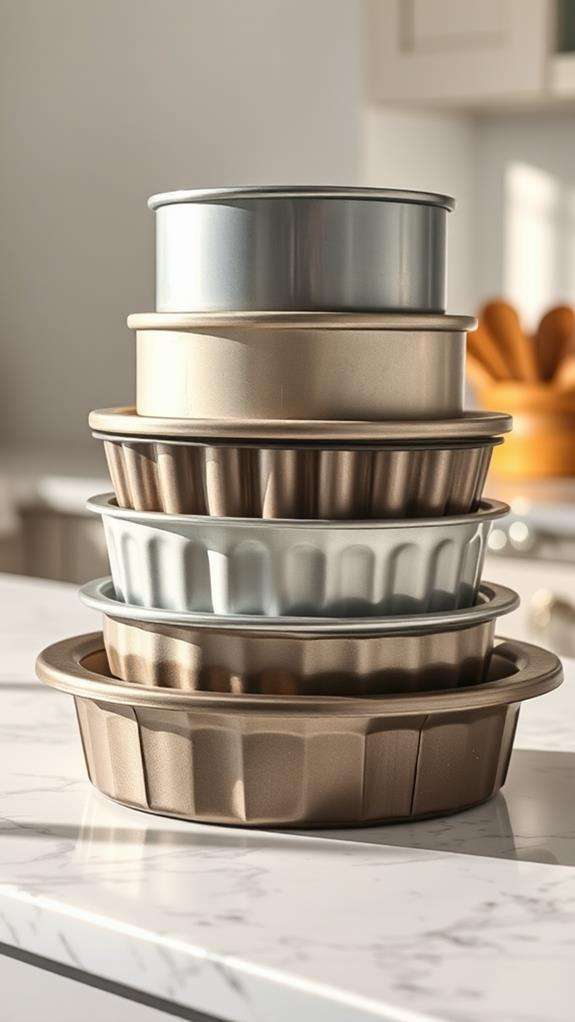
Without a Bundt pan in your kitchen, several practical alternatives can help you achieve similar results. The most effective substitute you'll find is a tube pan, which features the same central column design that's essential for your Bundt cake recipes. This design guarantees even heat distribution and helps maintain proper moisture levels throughout the baking process. For those who enjoy baking and cooking, having reliable measuring tools, like the Pyrex measuring cup set, can make the preparation of ingredients much simpler.
When you're working with standard baking pans, you've got multiple options at your disposal. You can use two 9-inch round cake pans as a substitute for a 10-12 cup Bundt pan, though you'll need to adjust your baking time accordingly. If you're feeling creative, you can create a makeshift Bundt pan by placing a well-greased ramekin in the center of a deep circular cake pan. To guarantee stability, you'll want to fill the ramekin with dried beans or pie weights.
For added versatility, you can turn to your springform pan, which offers easy release thanks to its removable sides. Don't forget to line it with parchment paper to prevent sticking. If you're working with smaller portions, muffin pans provide a practical alternative, especially when lined properly.
Creating Your DIY Ring Pan
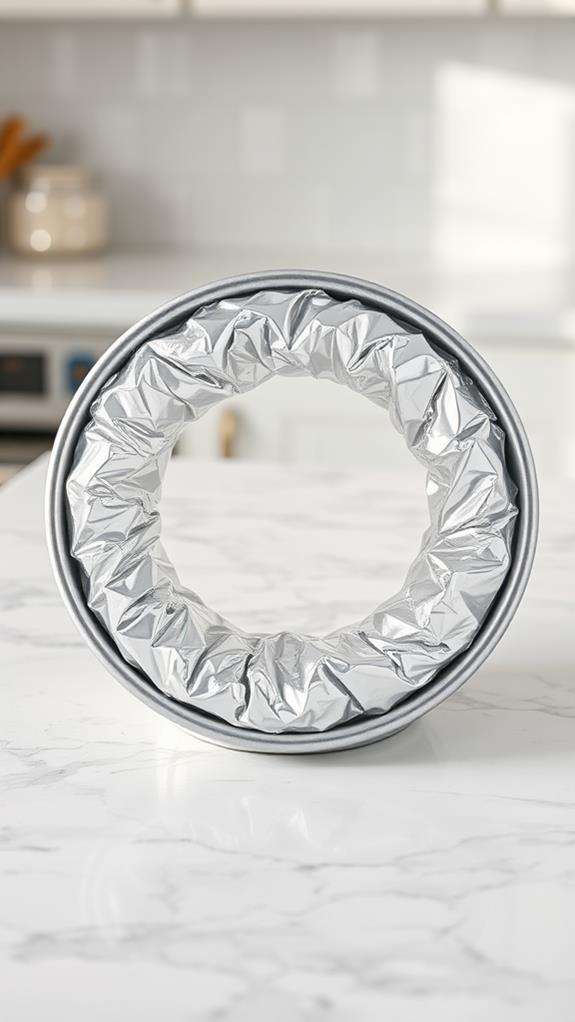
Crafting your own ring pan provides a clever solution when you don't have a Bundt pan on hand. You'll need a standard 9-inch round cake pan and a clean, empty soup can to create the distinctive ring shape that's characteristic of Bundt cakes.
To set up your DIY ring pan, start by thoroughly buttering both the cake pan and the empty can. Place the can in the center of your round cake pan, and fill it halfway with dried beans or pie weights to keep it stable during baking. This weight prevents the can from shifting and stops cake batter from seeping underneath.
You'll need to modify your baking time when using this alternative setup, as it typically requires about 10 minutes less than a traditional Bundt pan recipe. Keep an eye on your cake's progress and test for doneness by inserting a toothpick into the outer portion of the cake. Once baked, let your creation cool completely before attempting to remove the center can. This patience guarantees your cake maintains its shape and prevents any unfortunate breaks or crumbling.
Adapting Recipes Without Bundt Pan
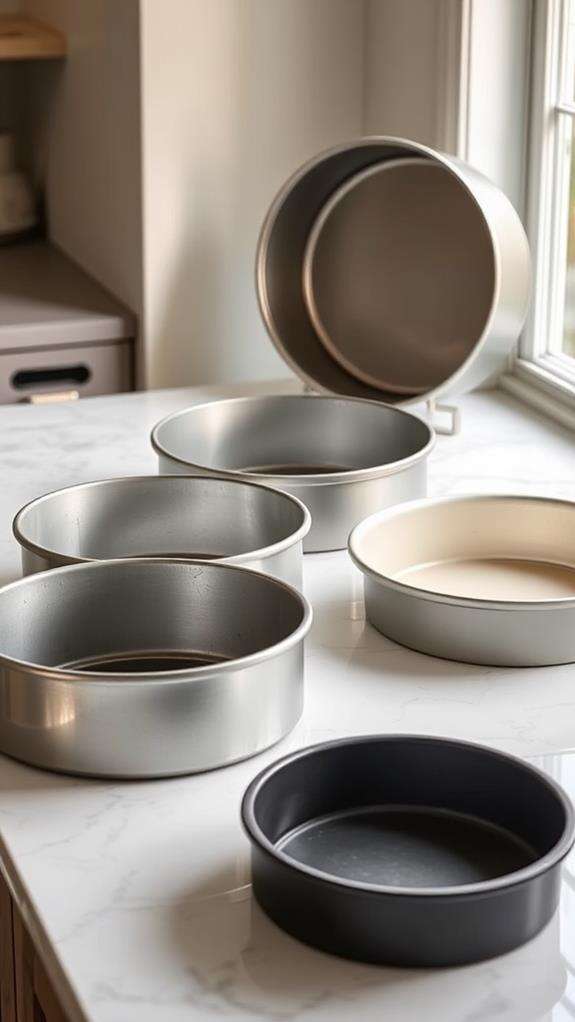
Successfully adapting a Bundt cake recipe requires careful attention to pan capacity and baking adjustments. When you're working without Bundt pans, you'll need to take into account both volume and temperature modifications to achieve the best results. Remember that most Bundt recipes yield 10-12 cups of batter, which means you'll likely need two standard 9-inch round pans as substitutes.
To guarantee your adapted recipes turn out perfectly, follow these key steps:
- Fill your substitute pans only 1/2 to 2/3 full to prevent overflow and allow proper rising
- Reduce your oven temperature by 25°F to accommodate the different pan depths
- Adjust your baking time accordingly, typically reducing it by 10-15 minutes when using tube pans
Before starting, you'll want to verify your substitute pan's capacity by measuring it with water. This simple test helps you match the volume requirements of your original recipe. When using alternative pans, keep a close eye on your cake's progress, as baking time can vary markedly from the original recipe. You'll know it's done when a toothpick inserted into the center comes out clean.
Best Pans for Ring Cakes
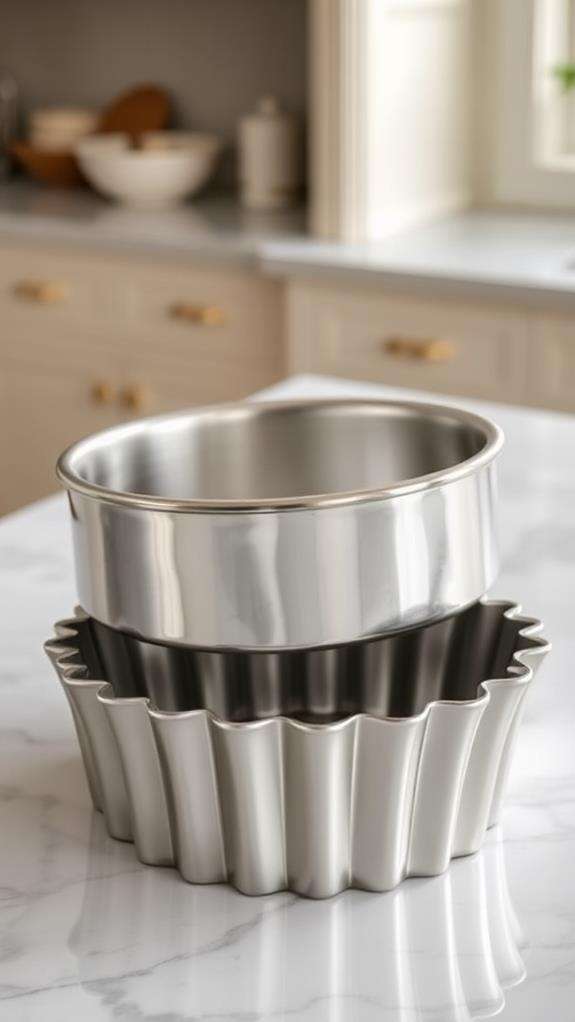
The most reliable substitute for a Bundt pan is a traditional tube pan, which shares many of the same characteristics that make ring cakes successful. You'll find that its central tube promotes even heat distribution, ensuring your cake bakes uniformly from edge to center.
When selecting alternative baking pans for your ring cakes, you'll need to take into account both the pan's shape and depth to achieve ideal results. Here's a helpful comparison of your options:
| Pan Type | Advantages | Adjustments Needed |
|---|---|---|
| Tube Pan | Even baking, similar depth | None required |
| Springform | Easy release, versatile | Add center tube substitute |
| Round Cake Pan | Readily available | Insert ramekin in center |
| Loaf Pans | Common household item | Adjust baking time down |
You'll need to monitor your baking time closely when using substitutes, as different pan depths can affect how quickly your cake bakes. If you're using a shallower pan, start checking for doneness about 10-15 minutes earlier than your recipe suggests. Remember to grease your chosen pan thoroughly and think about using parchment paper for easier release, particularly with springform pans.
Proper Pan Preparation Methods
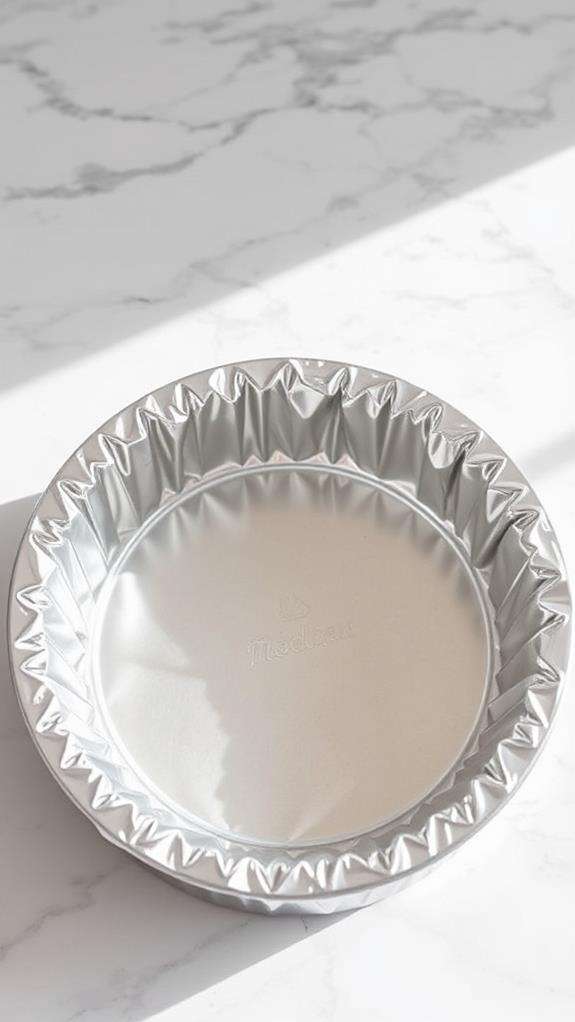
Once you've selected your substitute pan, proper preparation becomes your next priority for achieving a perfectly released cake. You'll want to start by thoroughly buttering every nook and cranny of your pan's interior surface, ensuring no spots are missed, as this creates an essential barrier for easy release after baking.
For best results when preparing your substitute pan, follow these essential steps:
- Line the bottom with parchment paper, cutting it to fit precisely, which provides an extra guarantee against sticking – especially important when working with pans that have detailed patterns.
- Position your center support (if using a makeshift tube pan setup) firmly in the middle before adding any batter.
- Fill your pan only to the two-thirds mark, allowing adequate space for the cake to rise during baking.
After you've completed these preparation steps, you'll be ready to pour in your batter. Remember to let your finished cake cool completely in the pan before attempting to release it. This cooling period is vital for maintaining the cake's structural integrity and ensuring a clean release from your substitute pan.
Baking Time and Temperature Adjustments
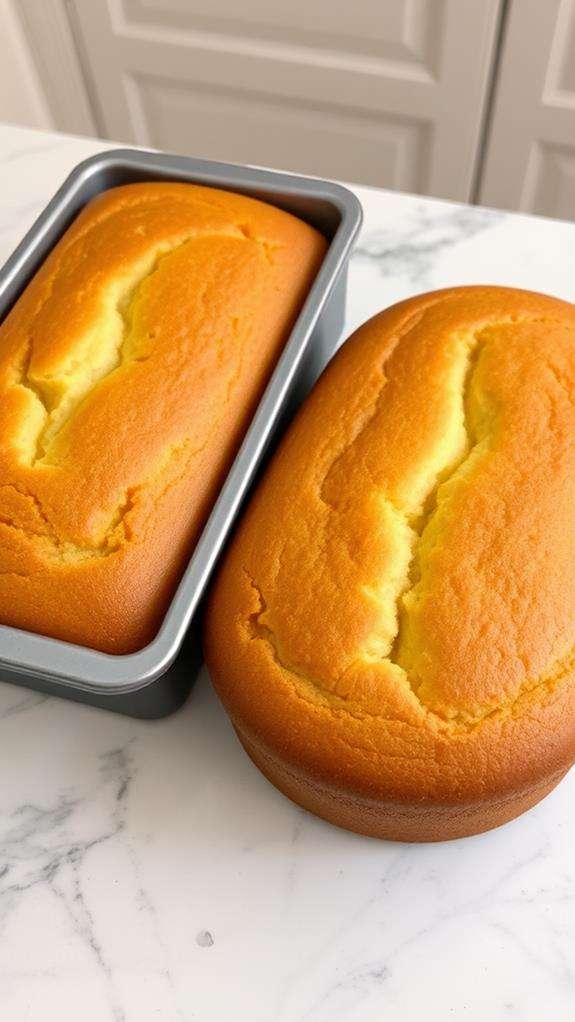
Making the switch to a substitute pan requires careful adjustments to both baking temperature and time. When you're using alternative bakeware, you'll need to modify your approach based on the specific pan size and style you've chosen.
For round cakes and other shallow pans, you'll want to reduce your oven temperature by 25°F from the original recipe to prevent burning around the edges. You should also check for doneness about 10-15 minutes earlier than you would with a Bundt pan, as these alternatives typically cook faster. If you're using a tube pan, expect your baking time to decrease by approximately 10 minutes due to its efficient heat circulation design.
When opting for larger pans, such as a 13×9-inch pan, you'll need to extend your baking time by 10-20 minutes compared to the original Bundt pan recipe. Regardless of which substitute you choose, it's essential to monitor your cake's progress and use the toothpick test to determine when it's fully baked. Insert a toothpick into the center of your cake; if it comes out clean, your cake is ready.
Tips for Perfect Release
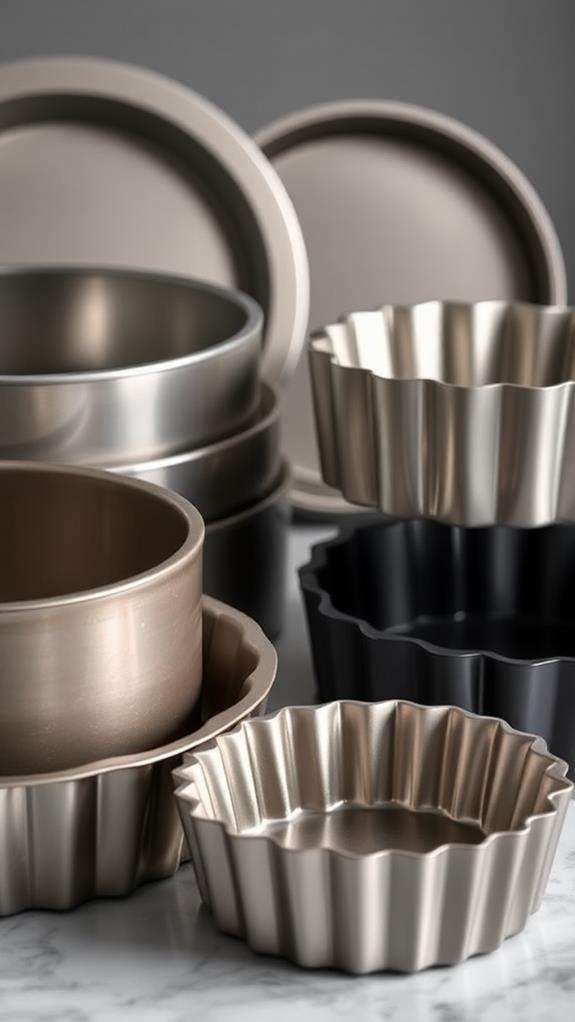
Your success in releasing a cake from a substitute pan starts with proper non-stick spray application and thorough greasing techniques, making sure to coat every crevice and corner of your alternative pan. When greasing your pan, you'll want to apply butter or cooking spray liberally, followed by a light dusting of flour to create multiple non-stick barriers that prevent sticking. After baking, you must let your cake cool for 10-15 minutes in the pan before attempting to unmold it, as this cooling period allows the cake's structure to set while remaining warm enough to release cleanly.
Non-Stick Spray Application
Proper non-stick spray application stands between success and disaster when using a bundt pan substitute. You'll need to be thorough when preparing your baking pan, as proper coverage guarantees your cake will release easily after baking. For superior results, choose a non-stick cooking spray that contains flour, which creates an excellent barrier against sticking compared to standard oil-based sprays.
When applying non-stick spray to your pan substitute, follow these important steps:
- Start with a clean, dry pan and spray generously, holding the can 6-8 inches away from the surface
- Pay extra attention to corners, crevices, and any decorative details, guaranteeing complete coverage
- Consider adding a parchment paper layer in areas where intricate designs might cause sticking
After spraying, examine the pan under good lighting to identify any missed spots that could cause problems later. Remember to let your finished cake cool for 10-15 minutes before attempting to remove it from the pan. This cooling period is vital for the cake's structure to set properly, preventing breaks or tears during removal.
Greasing Techniques Matter
Successful cake release relies heavily on mastering the right greasing techniques when using a Bundt pan substitute. You'll need to create a reliable non-stick barrier by thoroughly coating every surface, including the smallest crevices and corners of your alternative pan.
Start by applying a generous layer of butter or your preferred fat, making sure you're reaching all the intricate areas of your substitute pan. If you're using a can or ramekin as your alternative, don't skimp on greasing these surfaces either. After applying your fat, let it sit for a few minutes to properly adhere to the pan's surface. This waiting period is vital for creating an effective release barrier.
For enhanced results, you'll want to follow up with a dusting of flour, or if you're making a chocolate cake, consider using cocoa powder instead. This additional step creates an even more effective non-stick barrier. When using baking spray, make certain you're applying it evenly and thoroughly. Remember, proper greasing techniques are your best defense against sticking, so take your time with this essential step to guarantee a clean cake release.
Cool Before Unmolding
Patience plays an essential role when unmolding your cake from a Bundt pan substitute. After your baking times are complete, you'll need to resist the temptation to immediately remove your creation. Instead, allow the cake to rest in the pan for 10-15 minutes, giving it time to set properly and reducing the risk of breakage during removal.
For the most successful release, follow these vital steps:
- Let the cake cool for the initial 10-15 minutes while still in the pan, allowing it to contract slightly from the sides
- Run a thin knife or spatula around the pan's edges, ensuring you've loosened any stuck areas
- If you're working with an intricate design, consider extending the cooling time to prevent any structural issues
Once you're ready to unmold, hold your serving plate or wire rack firmly against the pan's opening and flip it over with confidence. If your cake doesn't release immediately, don't panic – simply tap the pan gently against your counter. Remember, proper cooling time is just as vital as your initial pan preparation and baking process for achieving that perfect, intact cake.
Frequently Asked Questions
What Can I Use if I Don't Have a Bundt Pan?
Just like how ancient Romans found creative solutions, you've got several options to replace a Bundt pan. You can use a tube pan, which works best as it has that vital center hole for even baking. Don't have one? Try using two 9-inch round cake pans, or create a DIY version by placing an oven-safe container in the center of a regular cake pan. A 13×9-inch pan's also an option, but you'll need to adjust baking times.
What Is the Equivalent of a Bundt Pan?
You can use a standard tube pan as the closest equivalent to a Bundt pan, as it shares the same center column design. If you're looking for volume capacity, two 9-inch round cake pans will match a typical 10-12 cup Bundt pan. You'll also achieve similar results with a deep circular cake pan paired with a ceramic ramekin in the center, though you'll need to adjust baking times accordingly.
Can You Substitute a Bundt Pan for a 9×13 Pan?
A Bundt pan typically holds 10-12 cups of batter, and you'll be glad to know you can substitute it with a 9×13-inch pan, which accommodates about 14 cups. You'll need to adjust your baking time since the 9×13 pan usually bakes faster – start checking about 10-15 minutes earlier than the recipe suggests. Remember to leave 1/2 inch of space at the top, and note that you won't get that signature decorative ring shape.
Do You Really Need a Bundt Pan?
You don't strictly need a Bundt pan to create delicious cakes. While it's great for achieving that distinctive ring shape and decorative patterns, you can easily use alternatives like tube pans, round cake pans, or even create a makeshift Bundt pan using a round pan with a clean can in the center. Just remember to adjust your baking time and confirm your substitute pan can hold the same volume of batter.





